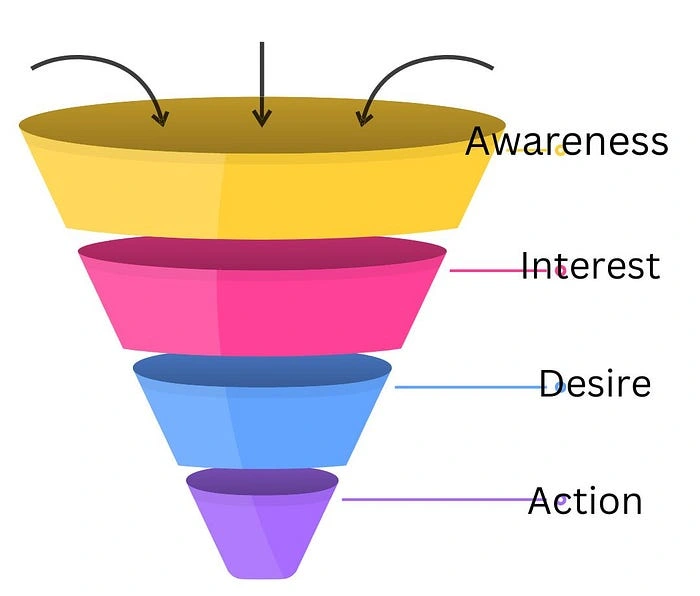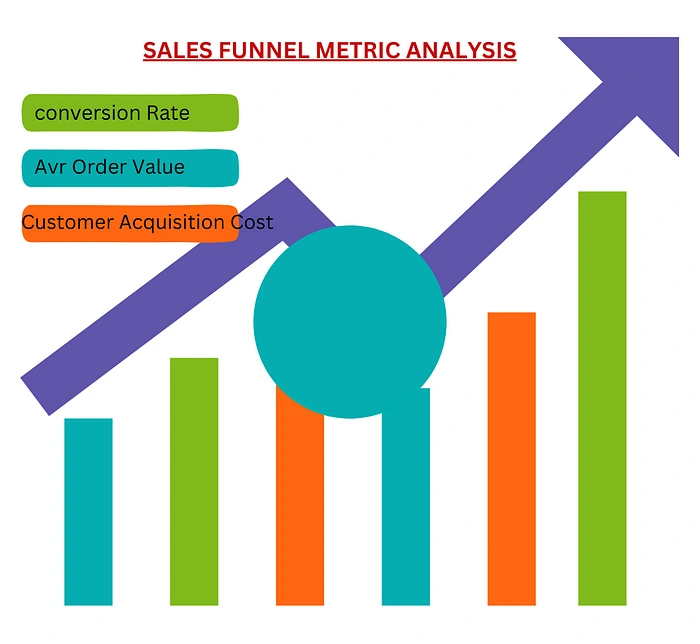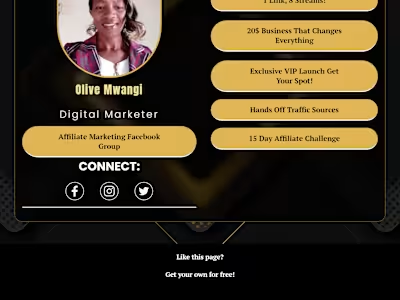The Ultimate Guide to Creating a High-Converting Sales Funnel
The Ultimate Guide to Creating a High-Converting Sales Funnel

·
11 min read
·
Mar 31, 2023
--

Creating a high-converting sales funnel in your business is crucial. It turns potential customers into loyal patrons of your business.
In today’s digital age, having a successful sales funnel is more important than ever. It can help businesses gain a competitive edge and increase their revenue.
Yet, many businesses need help to create a sales funnel strategy that delivers results. Some factors contribute to a successful sales funnel design. From understanding the customer journey to optimizing conversion rates.
That’s where this sales funnel blueprint comes in. It provides actionable tips and email templates to build a conversion funnel.
Are you starting or looking to optimize your existing sales funnel templates? I will help you drive conversions and boosts revenue with a streamlined lead-generation funnel.
So, let’s dive in and start building your high-converting sales funnel today!
What is a sales funnel?
We also know a sales funnel as a lead-generation funnel. It visually represents a potential customer’s process from start to end.
It is a framework that helps businesses to guide customers through the buying journey. From awareness to consideration to purchase and beyond.
The sales funnel comprises several stages a customer goes through. Let’s look at the 4 main phases most businesses need to be aware of.
1. Awareness:
The first stage is when a potential customer becomes aware of a product or service. The stage could happen through marketing. Such as advertising, social media, word of mouth, or other marketing efforts.
2. Interest:
The interest stage is when the customer asks about the product or service. They may visit a website, sign up for a newsletter, or engage with social media content.
3. Decision:
The decision stage is when the potential customer evaluates the product or service. And decide whether to buy it. The step may involve a few activities. They may read reviews, compare prices, or seek advice from friends or family.
4. Action:
The potential customer engages with the product or service in the action stage. He may buy or engage with the product or service in either way.
The goal of the sales funnel implementation is to guide potential customers through each stage.
Businesses use a variety of strategies to move customers through the sales funnel. Such as email marketing, retargeting ads, and special offers or promotions.
However, businesses increase their conversion rate once they understand the importance of building a marketing funnel.
What’s the importance of building a sales funnel in your business
The key reason is to engage the prospects and develop a streamlined sales strategy. The sales process will guide you to give a top-notch solution that leads to sales conversion and customer referrals.
Did you know the most qualified prospect can fall through the cracks in your marketing funnel?
Of course, yes,
But as you understand each step in your sales funnel metrics, winning your customer becomes easy.
Let's dig deep into the reasons for building a lead-generation funnel.
1. Increases Conversion Rates:
A well-structured process increases the lead conversion rate. All you need is value-packed content at each stage. The content should address solutions to customers’ pain points.
That’s how businesses build trust at every stage of the buyers’ journey.
2. Improves Customer Engagement:
A well-structured sales funnel template helps you engage with potential customers at critical touchpoints.
One can engage through educational content, personalized offers, and other strategies.
It builds relationships and encourages customer loyalty.
3. Streamlines Sales Process:
Businesses can streamline their sales process and drop inefficiencies.
It will save time and resources and improve customer experience.
What you need here is to identify critical stages in the customer journey. This depends on the type of business.
4. Provides Data Insights:
A sales funnel offers valuable customer behavior and preferences insights.
You get the most by tracking the sales funnel’s metrics, like conversion rates and customer engagement.
These insights will improve your data-driven decisions to optimize your sales process.
5. Increases Revenue:
Businesses can increase revenue by optimizing the lead generation funnel and improving conversion rates. It happens through cross-selling and upselling to maximize the value of each customer.
Even though building a lead-generation funnel is a hard task for any successful business strategy, it works where it’s entirely implemented.
If you get the best from every stage, businesses improve conversion rates, customer relationships, and ROI. All you need is to be in charge of the entire process.
How to Optimize and Manage the Sales Funnels
For sales funnel management to be effective in your business, you must provide value at each stage. The worth you provide makes them come closer to a closing win.
Remember, not all customers are the same. Each prospect demands a different strategy to win over.
Here are some tips for optimizing and managing a sales funnel:
1. Define Your Sales Funnel Stages:
The first step in optimizing and managing a sales funnel is to know the customer position. It starts from awareness to action and other stages relevant to your business.
2. Analyze Your Funnel Metrics:
Tracking and analyzing key metrics are essential. Such include conversion rates, click-through rates, and customer engagement.
Here, you need to check on the sales funnel metrics regularly.
3. Create Compelling Content:
The element of successful sales funnel management is providing valuable content at each stage.
Ensure the blog posts, videos, e-books, and other resources are value-packed. This means they address the pain points and offer solutions to potential customers.
4. Personalize Your Offers:
Personalization is essential to engaging potential customers and increasing conversions.
This is where segmentation comes in.
You tailor your messaging to specific needs and interests by segmenting your audience.
It improves engagement and increases the likelihood of a sale.
5. Use Retargeting Ads:
Retargeting ads can be a powerful tool for engaging clients.
It applies to potential customers who have visited your website. Or shown interest in your products or services.
Retargeting increase the likelihood of conversion by displaying relevant ads to these individuals.
6. Test and Iterate:
Sales funnel testing is not a one-time project. But an ongoing process of optimization and improvement. You can identify improvement in some areas by testing and iterating on your sales funnel software.
How to do a Sales Funnel Metric Analysis

To do a sales funnel metric analysis, you must analyze the stages of the buyers’ journey. You can use various sales funnel analysis tools like amplitude and contentsquare.
Here are the steps you need to follow for a sales funnel metric analysis.
1. Identify the Key Metrics:
Determine which metrics are most important to your business goals. Standard metrics include conversion rates, average order value, and customer acquisition cost.
2. Analyze Each Stage of the Funnel:
Break down the funnel into individual stages and analyze the metrics at each step.
For example, you may track the number of visitors to your website. Out of that number, get the percentage of visitors who sign up for your newsletter. Finally, get the rate of newsletter subscribers who buy.
3. Identify Bottlenecks:
Look for areas where potential customers drop out of the funnel. For example, if visitors leave your website before signing up for your newsletter. This may show a problem with your website design or messaging.
4. Test and Experiment:
Use A/B testing and other experimentation techniques to identify loopholes. This way will improve your sales funnel customer experience.
For example, you may try different messaging or offers at each funnel stage to see the most effective.
5. Track and Adjust:
Check your metrics often and adjust your strategies as preferred. Use the insights you gain from your funnel analysis to capture more leads.
How Can I use Email Marketing to Enhance the Sales Funnels Automation?
Email marketing is a powerful tool to advance your sales funnel automation. You can use email marketing to manage your leads by sending targeted emails.
One can use several types of emails according to the business type. But I’ve chosen a few templates to get you started.
Such as
· Welcome email
· Lead nurturing email
· Cart abandonment emails
· Re-engagement email
· Post-sell email
· Up-sell/cross-sell emails
Let’s see what you need to address in this template. You can edit the template and re-use it.
1. Welcome, Email:
Send a welcome email to new subscribers to introduce your brand and provide value.
This email can also include a call-to-action (CTA). It encourages subscribers to take the next step in the sales funnel.
Here’s a basic template for a welcome email:
Subject Line: Welcome to [Company Name]!
Dear [Subscriber Name],
Thank you for joining [Company Name] email list! We’re excited to have you as part of our community, and we can’t wait to share valuable content and offers with you.
You’ll know about new product launches and exclusive promotions as a subscriber. These helpful resources support your [relevant industry or topic]. We’ll also share insights and tips from our team of experts to help you [appropriate goal or benefit].
You can explore our website and follow us on social media to stay current on the latest news. If you have questions or feedback, please contact our team at [contact email].
Thanks again for joining our community!
Best,
[Your Name]
[Company Name]
2. Lead Nurturing:
Use email marketing to nurture and guide leads through the sales funnel. It includes sending targeted content, personalized offers, and reminders to complete specific actions.
You can use this basic template for a lead-nurturing email:
Subject line: [Subscriber Name], check out our latest content on [topic]
Dear [Subscriber Name],
I’m reaching out to share our latest content on [relevant topic]. We ensure you access valuable information to support your [relevant industry or goal].
Our latest article/blog post/podcast episode [insert title and link] provides valuable insights into [summary of content]. It is helpful as you [relevant action or aim].
We wanted to remind you of our [product/service/offer] that may interest you. [highlight the benefits or features of the product/service/offer].
As always, please contact our team with questions or feedback. We support and help you achieve your [relevant goal or benefit].
Best,
[Your Name]
[Company Name]
3. Cart Abandonment Emails:
Send cart abandonment emails to customers who have added items to their carts. Despite that, they need to complete the purchase. These emails offer incentives and encourage customers to complete the sale.
The basic template for a cart abandonment email has the details you need to win your customer back:
Subject Line: Remember your items in the cart!
Dear [Customer Name],
We noticed you added [product name] to your cart but still need to complete the purchase.
We understand life can get busy, and things can slip through the cracks. So we wanted to remind you of the items in your cart and offer a little incentive to help you complete your purchase.
As a loyalty gift, we’re offering [insert incentives, such as a discount or free shipping] on your order. Use the code [insert code] at checkout to redeem your offer.
If you need help to complete your purchase, contact our team at [contact email].
Thank you for considering our products, and we hope to hear from you soon!
Best,
[Your Name]
[Company Name]
4. Upsell/Cross-Sell Emails:
Use email marketing to promote additional products or services to existing customers. Previous purchases or customer behavior and interests can trigger these emails.
Use a template like this one for a cross-sell email:
Subject line: [Customer Name], check out our [related product/service]
Dear [Customer Name],
We hope you’re enjoying your recent purchase of [product/service]. As a valued customer, we want to inform you about a related product/service you are interested in.
Our [related product/service] is designed to complement your recent purchase and help you [insert relevant benefit]. [ highlight the features and benefits of the related product/service].
We’re offering [insert incentives, such as a discount or free shipping] on your order of [related product/service]. Use the code [insert code] at checkout to redeem your offer.
If you have need help to place your order, contact our team at [contact email].
Thank you for your continued support, and we hope you enjoy our [related product/service]!
Best,
[Your Name]
[Company Name
5. Re-Engagement Emails:
Send re-engagement emails to inactive subscribers to win them back. These emails can include special offers or content designed to pique their interest.
Have your customers gone silent? Use this template for a re-engagement email:
Subject line: [Customer Name], we miss you!
Dear [Customer Name],
We noticed that it’d been a while since you’ve interacted with our brand. And we wanted to see how you’re doing and share some exciting updates with you.
As a valued customer, we want to ensure that we provide you with the best possible experience. And keep you updated with our latest products, services, and offers.
If you’re no longer interested in receiving emails from us, unsubscribe below. But if you want to stay updated with our latest news and offerings, we’d love to have you back!
We’re offering [Discount or free shipping] on your next purchase. Use the code [insert code] at checkout to redeem your offer.
Thank you for considering our brand, and we hope to hear from you soon!
Best,
[Your Name]
[Company Name]
P.S. We’d love to hear from you if you have any feedback or suggestions for how we can better serve you! Please reply to this email and let us know.
6. Post-Purchase Emails:
Follow up with customers after a sale to thank them for their loyalty. It encourages them to provide feedback or leave a review. These emails can also include opportunities for more purchases or referrals.
Your loyal customers need to hear you congratulate them. Use this template for a post-purchase email:
Subject Line: Thank You for Your Purchase, [Customer Name]!
Dear [Customer Name],
We thank you for your recent purchase from [Company Name]. We hope you’re enjoying your new [product/service] and exceeding your expectations.
As a valued customer, we’d love to hear your feedback. We request you leave a review on our website or social media channels.
Your feedback helps us improve our products and services. Hence, meeting your needs.
We offer [insert related products/services] that might interest you. Check out our website for more information and use the code [insert code] at checkout. It will cut off [insert incentives, such as discounts or free shipping] on your next purchase.
If you have questions about your recent sale, contact our team at [contact email].
Thank you again for choosing [Company Name], and we hope to serve you again in the future!
Best,
[Your Name]
[Company Name]
Using email marketing enhances your sales funnel. And provide value to potential and existing customers. Also, build relationships and increase conversions and revenue.
Conclusion
In this comprehensive blog post, I share the ultimate guide to creating a high-converting sales funnel. The post began by highlighting the importance of having a lead-generation sales funnel in today’s digital age and outlined the key components of an effective sales funnel. I then explained the sales funnel stages, from awareness to purchase, and provided email templates for each stage.
The post also emphasized the importance of tracking and analyzing data to measure the success of your sales funnel. It provided tips and strategies for optimizing your marketing sales funnel to improve conversion rates and increase revenue.
This post is a valuable resource for businesses looking to create or optimize their sales funnel strategy. Following the tips outlined in this guide, businesses can create a streamlined, effective conversion funnel that delivers results.
Like this project
Posted Oct 30, 2024
How to create high-converting sales funnel in your business and email marketing snippets.






